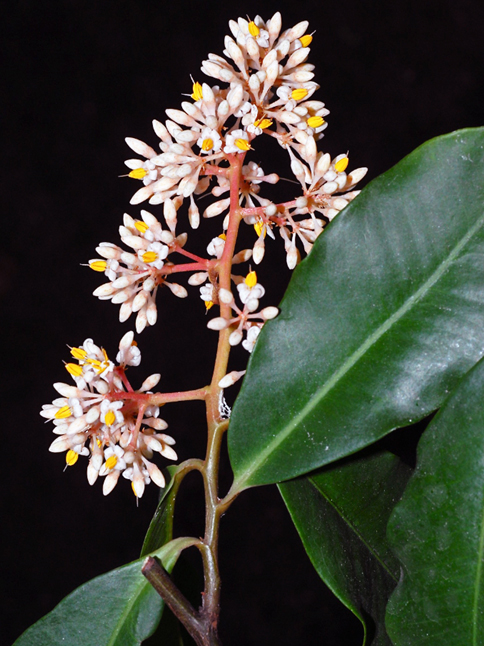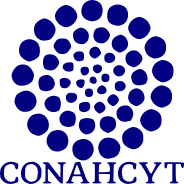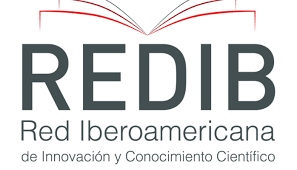Biological activity of ethanolic extracts of Ardisia compressa Kunth on whitefly Bemisia tabaci (Gennadius 1889, Hemiptera: Aleyrodidae) and a strain of Fusarium oxysporum Schltdl
DOI:
https://doi.org/10.18387/polibotanica.59.19Keywords:
Extracto vegetal, insecticida botánico, actividad repelente, actividad antifúngicaAbstract
The whitefly Bemisia tabaci and the fungus Fusarium oxysporum cause high economic losses in horticultural crops. Ardisia compressa is a plant species widely distributed in Southern Mexico, which has enormous potential to develop botanical products for pest control in agriculture. The aim of the present study was to evaluate the biological activity of ethanol extracts (EEs) from A. compressa leaves on B. tabaci and F. oxysporum, as well as to determine the chromatographic profile of the extracts. Leaves of 10 wild A. compressa populations from the State of Chiapas were collected and processed. Each A. compressa population obtained its respective EE at 0.2 % (w/v). The evaluation of toxic effects against B. tabaci showed that TCA and YRP extracts caused the highest mortality of eggs (98 and 99 %) and nymphs (97 %). The evaluation of repellent activity showed that TCA and CTia extracts had a greater effect on adults (38 and 30 %), and CJC and TCC extracts caused the highest oviposition deterrence (28 and 26 %). The evaluation of antifungal activity [100 and 200 μg mL-1] on F. oxysporum, showed that CJC extract caused the greatest mycelial growth inhibition (75 and 79 %, respectively). The correlation analysis using heat maps showed that the toxicity and repellent effects of A. compressa extracts on B. tabaci were correlated with the highest concentrations of oleic acid, (Z,Z,Z)-9,12,15-octadecanotrienoic acid, octadecanoic acid, 3-ethyl-5-(2-ethylbutyl)-octadecane; (Z)-18-octadec-9-enolide, and γ-tocopherol. In the same way, the mycelial growth inhibition of F. oxysporum was associated with a high concentration of neophytadiene.
References
Akhtar, Y., Pages, E., Stevens, A., Bradbury, R., da Camara, C. A. G., & Isman, M. B. (2012). Effect of chemical complexity of essential oils on feeding deterrence in larvae of the cabbage looper. Physiological Entomology, 37(1), 81-91. https://doi.org/10.1111/j.1365-3032.2011.00824.x.
Altieri, C., Cardillo, D., Bevilacqua, A., & Sinigaglia, M. (2007). Inhibition of Aspergillus spp. and Penicillium spp. by fatty acids and their monoglycerides. Journal Food Protection, 70 (5), 1206-1212.
Anjum, B., Kumar, R., Kumar, R., Prakash, O., Srivastava, R. M., & Pant A. (2019). Phytochemical analysis, antioxidant, anti-inflammatory and insect antifeeding Activity of Ardisia solanacea Roxb. Extracts. Journal of Biologically Active Products from Nature, 9(5), 372- 386, https://doi.org/10.1080/22311866.2019.1702899
Bajracharya, G. B. (2015). Diversity, pharmacology and synthesis of bergenin and its derivatives: Potential materials for therapeutic usages. Fitoterapia, 101, 133-152. https://doi.org/10.1016/j.fitote.2015.01.001.
Carrillo-Morales, M., Wong-Villarreal, A., Aguilar-Marcelino, L., Castañeda-Ramírez, G. S., Pineda-Alegría, J. A., & Hernández-Núñez, E. (2022). Chemical composition and antifungal and nematicidal activities of the hexanic and methanolic extracts of Syzygium aromaticum. Science Asia, 48(1), 1-7. https://doi.org/10.2306/scienceasia1513-1874.2022.143.
Chatatikum, M., & Chiabchalard, A. (2017). Thai plants with high antioxidant levels, free radical scavenging activity, anti-tyrosinase and anti-collagenase activity. BMC Complementary and Alternative Medicine, 17(1), 487. https://doi.org/10.1186/s12906-017-1994-7.
Cruz-Cerino, P., Cristóbal-Alejo, J., Ruiz-Carrera, V., Carnevali, G., Vera-Ku, M., Martín, J., & Gamboa-Angulo, M. (2020). Extracts from six native plants of the Yucatán Peninsula hinder mycelial growth of Fusarium equiseti and F. oxysporum, pathogens of Capsicum chinense. Pathogens, 9(10), 827. https://doi.org/10.3390/pathogens9100827.
Cruz-Estrada, A., Gamboa-Angulo, M., Borges-Argáez, R., & Ruiz-Sánchez, E. (2013). Insecticidal effects of plant extracts on immature whitefly Bemisia tabaci Genn. (Hemiptera: Aleyrodidae). Electronic Journal of Biotechnology,16(1), 6-6. https://doi:10.2225/vol16-issue1-fulltext-6.
Cruz-Estrada, A., Ruiz-Sánchez, E., Cristóbal-Alejo, J., González-Coloma, A., Andrés, M. F., & Gamboa-Angulo, M. (2019a). Medium-chain fatty acids from Eugenia winzerlingii leaves causing insect settling deterrent, nematicidal and phytotoxic effects. Molecules, 24(9), 1724. https://doi.org/10.3390/molecules24091724.
Cruz-Estrada, A., Ruiz-Sánchez, E., Medina-Baizabal, I. L., Balam-Uc, E., & Gamboa-Angulo, M. (2019b). Effect of Eugenia winzerlingii extracts on Bemisia tabaci and evaluation of its nursery propagation. Phyton, 88(2), 161. https://doi.org/10.32604/phyton.2019.05809.
Deng, J., Xiao, X., Tong, X., & Li, G. (2010). Preparation of bergenin from Ardisia crenata Sims and Rodgersia sambucifolia Hemsl based on microwave-assisted extraction/high-speed counter-current chromatography. Separation and Purification Technology, 74(2), 155-159. https://doi.org/10.1016/j.seppur.2010.05.018.
Di Rienzo, J. A., Casanoves, F., Gonzalez, L. A., Tablada, E. M., Díaz, M. P., & Balzarini, M. G. (2018) InfoStat ver2018. Grupo InfoStat, FCA. Universidad Nacional de Córdoba, Argentina.
Dikhoba, P. M., Mongalo, N. I., Elgorashi, E. E., & Makhafola, T. J. (2019). Antifungal and anti-mycotoxigenic activity of selected South African medicinal plants species. Heliyon, 5, 1-9. https://doi.org/10.1016/j.heliyon.2019.e02668.
García-Pérez, J. A., Alarcón-Gutiérrez, F., & Torres Pelayo, V. R. (2021). Extractos acuosos de plantas como inhibidores de la germinación de urediniosporas de Hemileia vastatrix; la roya anaranjada del café. Alianzas y Tendencias BUAP, 6(21), 45-60. http://doi.org/10.5281/zenodo.5104813.
Gonzales de Mejia, E., & Ramirez-Mares, M. V. (2011). Ardisia: health-promoting properties and toxicity of phytochemicals and extracts. Toxicology Mechanisms and Methods, 21(9), 667-74. https://doi.org/10.3109/15376516.2011.601355.
Herrera-Gorocica, A. M., Hernández-Núñez, E., Calvo-Irabien, L. M., Sánchez-Contreras, A., Ruiz-Jiménez, A. L., Latournerie-Moreno, L., Ballina-Gómez, H. S., & Ruiz-Sánchez, E. (2023). Efecto del aceite esencial de Lippia origanoides Kunth y dos de sus compuestos orgánicos volátiles sobre Tetranychus urticae Koch (Acari: Tetranychidae) y Bemisia tabaci Genn (Hemiptera: Aleyrodidae) en invernadero. Tropical and Subtropical Agroecosystems, 26(3), 080. http://doi.org/10.56369/tsaes.4413.
Jouwa Tameye NS, Mvot Akak C, Mouthé Happi G, Frese M, Stammler H-G, Neumann B, Ndjakou Lenta B, Sewald N, Nkengfack AE. (2020). Antioxidant norbergenin derivatives from the leaves of Diospyros gilletii de Wild (Ebenaceae). Phytochem.estry Letters. 36, 63-67. https://doi.org/10.1016/j.phytol.2020.01.012.
Kobayashi, H., & González de Mejía, E. (2005). The genus Ardisia: a novel source of health-promoting compounds and phytopharmaceuticals. Journal Ethnopharmacology, 96(3), 347-354. https://doi.org/10.1016/j.jep.2004.09.037.
Ma, L., Zhang, M., Otsuki, K., Lei, Y., Kikuchi, T., Wang, Y., & Li, W. (2023). Simultaneous quantitative determination of six triterpenoid saponins in Ardisia japonica collected from different regions of China through LC-ESI-MS. Pharmacognosy Research, 15(1), 138-144. http://doi.org/10.5530/097484900260.
Malka, O., Feldmesser, E., Van Brunschot, S., Santos‐García, D., Han, W. H., Seal, S., Colvin, J., & Morin, S. (2021). The molecular mechanisms that determine different degrees of polyphagy in the Bemisia tabaci species complex. Evolutionary applications, 14(3), 807-820. https://doi.org/10.1111/eva.13162.
Martínez-Blanco, A., Almeraya-Quintero, S. X., Guajardo-Hernández, L. G., Pérez-Hernández, L. M. & Regalado-López, J. (2019). La utilidad de Ardisia compressa Kunth en parcelas cafetaleras. AgroProductividad, 12(9), 41-46. https://doi.org/10.32854/agrop.v12i9.1468.
Martínez-Solórzano, G. E., Rey-Brina, J. C., Pargas-Pichardo, R. E., & Enrique-Manzanilla, E. (2020). Fusarium wilt by tropical race 4: Current status and presence in the American continent. Revisión bibliográfica. Agronomía Mesoamericana, 31(1), 259-276. http://dx.doi.org/10.15517/am.v31i1.37925.
Mehta, S., Kadian, V., Dalal, S., Dalal, P., Kumar, S., Garg, M., & Rao, R. 2022. A Fresh Look on Bergenin: Vision of its novel drug delivery systems and pharmacological activities. Future Pharmacology, 2, 64-91. https://doi.org/10.3390/futurepharmacol2010006.
Navas-Castillo, J., Fiallo-Olivé, E., & Sánchez-Campos, S. (2011). Emerging virus diseases transmitted by whiteflies. Annual review of phytopathology, 49, 219-248. https://doi.org/10.1146/annurev-phyto-072910-095235.
Nazeh, A. N. M., Nor, Z. M., Mansor, M., Zajmi, A., Hasan, M. S., Azhar, F., & Kassim, M. (2017). Phytochemical constituents, antioxidant and antibacterial activities of methanolic extract of Ardisia elliptica, Asian Pacific Journal of Tropical Biomedicine, 7(6): 569-576. https://doi.org/10.1016/j.apjtb.2017.05.010.
Neal Jr, J. W., Davis, J. C., Bentz, J. A., Warthen Jr, D. J., Griesbach, R. J., & Santamour Jr, F. S. (1998). Allelochemical activity in Ardisia species (Myrsinaceae) against selected arthropods. Journal of economic entomology, 91(3), 608-617. https://doi.org/10.1093/jee/91.3.608.
Newell, A. M. B., Yousef, G. G., Lila, M. A., Ramírez-Mares, M. V., & Gonzalez de Mejia E. (2010). Comparative in vitro bioactivities of tea extracts from six species of Ardisia and their effect on growth inhibition of HepG2 cells. Journal of Ethnopharmacology, 130(3), 536-544. https://doi.org/10.1016/j.jep.2010.05.051.
Pournami, T. S., & Pratap, C. R. (2021). Evaluation of phytochemical and antimicrobial properties of leaf extracts of Ardisia solanacea Roxb. collected from Pathiramanal Island, Alappuzha District, Kerala State, India. Arabian Journal of Medicinal & Aromatic Plants, 7(1), 175-191. https://doi.org/10.48347/IMIST.PRSM/ajmap-v7i1.22649.
Ramos-López, M. A., González-Chávez, M. M., Cárdenas-Ortega, N. C., Zavala-Sánchez, M. A., & Pérez-Gutiérrez, S. (2012). Activity of the main fatty acid components of the hexane leaf extract of Ricinus communis against Spodoptera frugiperda. African Journal of Biotechnology, 11, 4274-4278. http://doi.org/10.5897/AJB11.3727.
Sandoval-Mojica, A. F., & Capinera J. L. (2011). Antifeedant effect of commercial chemicals and plant extracts against Schistocerca americana (Orthoptera: Acrididae) and Diaprepes abbreviatus (Coleoptera: Curculionidae). Pest management science, 67(7), 860-868. https://doi.org/10.1002/ps.2125.
Schindler, F., Fragner, L., Herpell, .J. B., Berger, A., Brenner, M., Tischler, S., Bellaire, A., Schönenberger, J., Li, W., Sun, X., Schinnerl, J., Brecker, L., Weckwerth, W., & Weckwerth, W. (2021). Dissecting metabolism of leaf nodules in Ardisia crenata and Psychotria punctata. Frontiers in Molecular Biosciences, 8, 683671. https://doi.org/10.3389/fmolb.2021.683671.
Singh, B., & Singh, S. (2003). Antimicrobial activity of terpenoids from Trichodesma amplexicaule Roth. Phytotherapy Research, 17, 814-816. https://doi.org/10.1002/ptr.1202
Syed, E., Mashroor, B., Hossain, F. M. D., Bi-Illah, N., Bhattacharjee, R., & Hannan, J. M. A. (2013). Evaluation of phytochemical screening and antimicrobial activities of ethanolic extracts of leaves and bark of Ardisia colorata. International Journal of Pharmaceutical and Life Sciences, 2(4), 158-164. https://doi.org/10.3329/ijpls.v2i4.17115.
Tian-Liang, Xie, Q., Shama, R., Yu, J., Xi-Gu-Ri-Gan, Bao, Q., Su, H., Liu, B., & Borjigidai, A. (2024). Ethnobotanical study of Zhuang medicinal herbs of Ardisia: variety systematization, traditional uses, phytochemistry, pharmacology, clinical application, and toxicity. The Journal of pharmacy and pharmacology, 76(4), 327–353. https://doi.org/10.1093/jpp/rgad119.
Valencia-Botín, A. J., Gutiérrez-Lomelí, M., Morales-del-Rio, J. A., Guerrero-Medina, P. J., Robles-García, M. A., Ruiz-Cruz, S., Wong-Corral, F. J., Borboa-Flores, J., Rueda-Puente, E. O., & del Toro-Sánchez, C. L. (2018). Inhibitory effect of Vitex mollis kunth extracts against bacteria and Fusarium species of human and agricultural importance. Revista Fitotecnia Mexicana, 41(4), 353-363. https://doi.org/10.35196/rfm.2018.4.353-363.
Wong, P. L., Ramli, N. S., Tan, C. P., Azlan, A., & Abas, F. (2021). Metabolomic analysis reveals the valuable bioactive compounds of Ardisia elliptica. Phytochemical Analysis, 32(5), 685-697. https://doi.org/10.1002/pca.3015.

Downloads
Published
License

Polibotánica by Departamento de Botánica de la Escuela Nacional de Ciencias Biológicas del Instituto Politécnico Nacional se distribuye bajo una Licencia Creative Commons Atribución-NoComercial-CompartirIgual 4.0 Internacional.



















